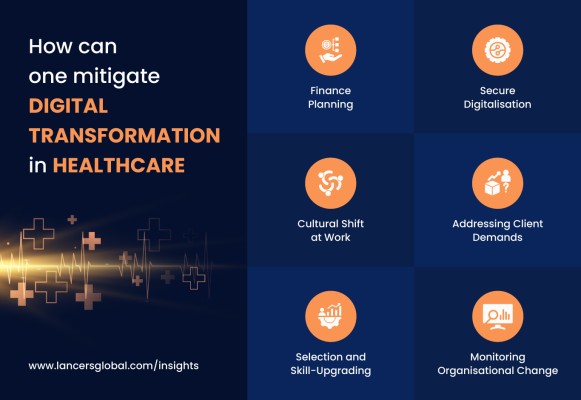Debunking the Myths and Unveiling Realities of Healthcare's Digital Transformation
Digital transformation has promised to revolutionise the healthcare industry by leveraging technology to improve patient outcomes, streamline processes, and bring cost-effective methods. However, despite the potential benefits, digital transformation initiatives in healthcare often fall short of expectations. According to a McKinsey analysis, the success rate of digital transformation in conventional industries like healthcare and pharmaceuticals ranges between 4% and 11%, while the success rate in other digitally savvy industries is 26%, which is much higher.
The reasons for the failure of digitalisation execution can be complex and multifaceted, ranging from resistance to change to data privacy and security concerns to inadequate technology infrastructure. Achieving true digital transformation is a difficult task that cannot be accomplished by simply incorporating a few critical digital elements. Regrettably, many efforts towards transformation have resulted in negative outcomes. For instance, healthcare organisations had the highest cost of data breaches compared to other industries, with an average cost of $7.13 million per breach in spite of these outcomes, only 9% of hospitals had adopted all of the recommended privacy and security measures for EHRs.
For your organisation to succeed in digital transformation, it is crucial that the interconnected areas of technology, data, processes, and organisational adaptability are strong. Even with good intentions, a transformational initiative may not yield the desired results if these areas are lacking. Consequently, to attain success, leaders must engage in more collaboration and coordination than they may be willing to undertake. Let's explore some of the common reasons why digital transformation initiatives fail in healthcare, the myths vs. realities about the real face of digital healthcare, and its hesitant attempts at achieving the 360-degree transformation.
Myths Vs Realities: Busting the misconceptions about the digital healthcare
Healthcare digital transformation is a trending issue in the industry today, with many organisations and providers investing in technology to improve patient care and outcomes. But digital transformation in healthcare is not a panacea for all the industry's problems. While it has the potential to improve healthcare outcomes,there are also reckless myths and misconceptions that are clouding the reality of the situation. In this section of the blog, we will explore some of the most common myths and realities surrounding healthcare digital transformation and putting down all the hypes around the practice.
Myth: Digital transformation in healthcare is a silver bullet that can solve all problems.
Reality: Digital transformation is a tool, not a magic solution. While it has the potential to improve healthcare outcomes, it is not a silver bullet. It is only one part of a broader strategy to improve the healthcare system and address the complex challenges facing the industry.
Myth: Digital transformation in healthcare is easy and can be implemented quickly.
Reality: Digital transformation in healthcare is a complex process that requires significant investment in time, money, and resources. Implementing digital solutions often requires significant changes to existing workflows and systems, which can be difficult to navigate.
Myth: Digital transformation in healthcare will lead to cost savings.
Reality: While digital solutions can streamline processes and reduce costs in some areas, they often require significant investments in hardware, software, and personnel. Additionally, digital solutions can create new expenses, such as training and maintenance costs.
Myth: Patients are eager for digital transformation in healthcare.
Reality: According to some healthcare professionals, patients' lack of trust in these digital solutions and apps is a barrier to their use, which makes them less valuable to healthcare providers and facilities. Considering the prevalence of data breaches and compromised personal data, it is obvious that patients are hesitant to trust their health information to digital services and apps.
Myth: Digital transformation in healthcare will eliminate the need for human healthcare providers.
Reality: While digital solutions can automate some tasks, they cannot replace the expertise and empathy of human healthcare providers.It is not about replacing human interaction, but rather augmenting it. Technology can help healthcare providers deliver better care and engage with patients in more personalised and efficient ways.
Myth: Digital transformation in healthcare will solve issues related to privacy and data security.
Reality: The idea that digital transformation in healthcare can resolve privacy and data security concerns is a myth. In fact, implementing digital solutions can introduce new risks related to privacy and data security. This is especially true when the solutions are not properly managed or implemented. Healthcare organisations must be cautious when adopting digital tools and ensure that they are taking the necessary steps to protect patients' personal information.
Why does the healthcare industry fail to cope with the digital transformation?
Several healthcare and life sciences firms encounter challenges when trying to undergo digital transformation and deliver the promised value to patients. There are a few primary reasons why healthcare organisations struggle to adopt digital transformation:

1. Out-of-date IT systems
Without a modernised infrastructure, data encryption can be challenging. According to 45% of IT leaders, the old legacy infrastructure poses a significant barrier to digital transformation. In healthcare and life sciences, the importance of essential data for providing a connected patient experience and driving insights and business decisions is being recognized. However, to access this data, multiple data sources and applications must transmit information quickly, efficiently, and securely. Unfortunately, many healthcare and life sciences systems rely on outdated legacy infrastructure, leading to fragmented and isolated technology.
2. IT roadblocks
Without a doubt, expectations for IT teams are rising faster than either the teams' own resources or their own budgets. This is often referred to as the IT delivery gap. IT staff are already stretched thin trying to keep up with the rapidly expanding demands of the digital world, and now they are being asked to work faster. Organisations can solve this issue by modernising the healthcare data integration platforms that are currently in place.
3. Issues regarding security and governance
Healthcare is always prioritised for security. It is essential to adhere to HIPAA standards, Medicare and Medicaid rules, and new government restrictions. Your organisation may be digitally transformed at scale without worrying about governance or security challenges. Data, systems, and APIs are protected on multiple levels when modern API-led strategy is used. Having visibility into all assets while governing your data and APIs from a single platform is also essential.
4. Data silos and inadequate data methods for amalgamation
Numerous applications for healthcare and life science businesses can be found in all sectors of the economy. However, only a small portion of data and applications are combined and utilised to advance the company's operations. A current data integration solution is crucial for advancing contemporary projects, whether a healthcare organisation is building new data connections, developing a 360-degree patient perspective, supporting contact centres, or expediting clinical trials. Most healthcare organisations must swiftly and securely unlock, integrate, and exploit complex, bi-directional consumer data streams in order to take advantage of digital innovation.
5. Ageing infrastructure
Without a modernised healthcare data integration architecture, it becomes difficult to unlock complicated, bi-directional customer data streams. Numerous IT leaders identified outdated architecture as a major obstacle to advancing plans for digital transformation. Many healthcare and life sciences organisations are downplaying the significance of very vital data and its impact on gaining actionable insights and making well-informed decisions in order to deliver seamless, well-connected patient experiences. Healthcare IT infrastructure must be agile, flexible, and scalable to address IT weaknesses immediately or risk falling behind in the present digital age.
6. Governance and safety hazards
For businesses in the healthcare and life sciences industries, security is crucial. Healthcare organisations can guarantee healthcare security with the use of contemporary healthcare data integration solutions. Only authenticated users can access healthcare data and use it to provide the value promised to patients and high-quality care thanks to the end-to-end secured environment and AI-driven methodology. Data silos, obsolete healthcare integration design, technical constraints, and data security issues continue to be obstacles. To undergo a digital transformation, businesses must take use of contemporary data integration platforms with self-service and automated features.
7. Inadequate budget allocation
A healthcare app takes a long time to develop because of the time needed for research, product development, and knowledge sharing, as well as because any healthcare product must clear regulatory requirements. It's extremely likely that the product will go through revisions and refinements over this time because many factors, such as industry regulations and requirements, may alter. A budget that can accommodate last-minute adjustments is essential, as are enough resources to make sure you don't run out of petrol before the project is finished.
8. Not comprehending the issue
The problem that entrepreneurs and creators are seeking to solve in the first place is one of the major obstacles they encounter while creating digital healthcare digital solutions. In reality, less than 30% of professionals believe that their healthcare organisation is giving consumers a best-in-class digital experience. Many healthcare-related goods fall flat because they either don't completely comprehend what it takes to tackle the problem they're supposed to be treating or they are just not focused on it.
Top challenges of digital transformation in healthcare
The healthcare industry confronts a multitude of challenges that include demographic shifts, regulatory demands, technological developments, financial restrictions, and several others. These obstacles create roadblocks for delivering exceptional healthcare services to patients. To overcome these challenges, it is necessary for governments, healthcare providers, insurers, patients, and technology companies to work together collaboratively. In this regard, it is important to explore the top challenges in healthcare industry and their possible remedies.
1. Escalating costs of Healthcare
2. Keeping abreast of developments in medical science
3. Outdated payment model
4. Threats to Cyber Security
5. Complexities in data management
For these challenges there are a few solutions which include value-based care models to reduce costs and improve care quality, continuous education for healthcare professionals to stay updated, innovative payment models that align with patient needs, robust cybersecurity measures, and big data analytics to improve diagnosis, treatment, and outcomes. Addressing these challenges can lead to a sustainable healthcare system that provides access to high-quality care while reducing financial burdens on individuals and families.
How can one mitigate digital transformation in healthcare?
A major step towards a successful digital transformation journey is surely achieving the ideal balance. Organisations must have a distinct strategy and incorporate it into each of their processes. To start with there are certain essential ingredients for every successful digital transformation. In this section we are discussion them to make your transition:

1. Monitoring organisational change
Effective organisational change management involves careful planning, involvement of upper management, creating a roadmap, and regular monitoring and measuring progress using data and analytics. A detailed plan is necessary, including analysis of processes, prioritisation of tasks, and alignment with the organisation's vision and objectives. Upper management should be involved in decision-making and communication of proposed changes, while regular feedback is encouraged. A roadmap helps employees understand the transformation journey and set timelines. Data and analytics provide insights into enhancements and issues to address, enabling continuous evaluation of the process and making adjustments as necessary.
2. Selection and skill-upgrading
One of the biggest obstacles to digital transformation is a lack of competence. The necessity for competent workers to continue the process should be understood by organisations, and if necessary, they should carefully consider investing in hiring new staff members who possess the necessary expertise, skills, and knowledge.
Another crucial step towards success is to add leaders that are well knowledgeable with digital processes and wholly committed to transformation. Additionally, staff members need to be hired and trained on how to use new equipment and get ready for emerging innovations.
3. Addressing client demands
The fundamental influence of digital transformation on customer experiences. Organisations must remain on top of the most recent trends and educate themselves continually about new approaches, techniques, and technologies created to improve customers' experiences if they are to fulfil customers' expectations and demands, which are constantly changing.
4. Cultural shift at work
Now that the human aspect has been proven, it is important. According to Forbes, starting the change process with people rather than technology is the key to an organisation's success in the digital sphere. By educating employees on the significance of digital transformation and other associated issues, organisations can seek to improve the organisational culture as a whole. A smart healthcare strategy transformation for reducing employee resistance to change is to involve the entire team from the start and maintain open, regular communication with them.
5. Secure digitalisation
A successful and safe change requires that risks are recognised and managed during the digital transformation process. Employers should be trained, and organisations should invest in new equipment and technology, establish risk management, and apply security controls and regulations.
6. Finance Planning for digital transformation
In addition to the time input, digital transformation necessitates a significant financial investment that must be carefully managed. A financial road map should be developed by organisations to streamline the procedures. It is advisable to create a budget based on your overall objectives, requirements, strategies, priorities, deadlines, anticipated results, return on investment, etc. The budget needs to be adaptable in case new difficulties or problems arise.
Even while the difficulties of digital transformation may appear disheartening to some organisations, success can be accomplished and the rewards will make all the effort worthwhile with the correct mindset, resources, and effort.
How can Global Lancers facilitate the digital transformation of the healthcare industry?
In the view of the facts presented, the digital healthcare sector is rapidly expanding and revolutionising the healthcare industry in unprecedented ways. It is crucial to differentiate between myths and realities and comprehend its actual potential. By understanding these misconceptions, you can avoid getting caught up in the hype around digital transformation. Utilising digital transformation solutions in healthcare can help your company succeed, and it is essential to stay updated on the progress of the process.
Global Lancers is an excellent partner for transforming the way digital healthcare industries function. Our in-house teams of skilled developers can integrate the latest advancements in technologies like AI, IoT, AR, and ML to assist our esteemed clients in taking advantage of digital transformation solutions. As businesses adapt to digital operations, we aid them in improving accessibility, enhancing patient engagement, increasing efficiency, and making better decisions about what to prioritise in the journey towards 360-degree transformation.
Recent Posts








Add Comment
0 Comments